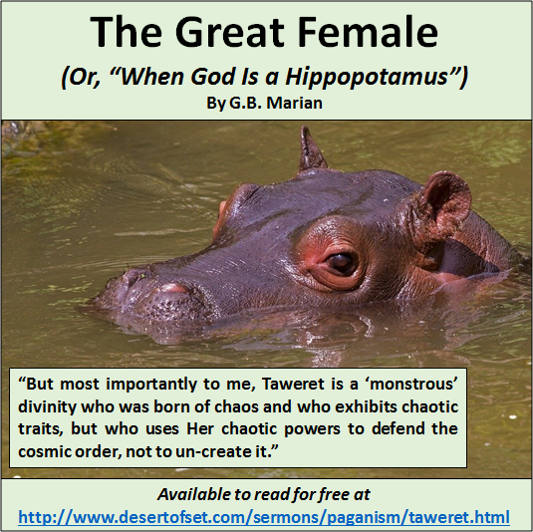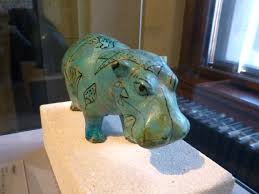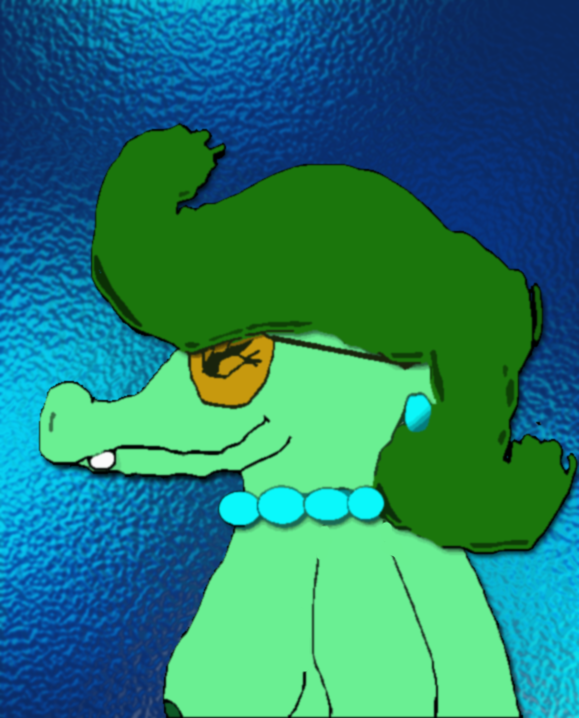

Taweret is the Egyptian hippo goddess of childbirth. Her name means “Great Female,” and She is otherwise known as Taurt, Reret, Apet, or Thoueris. According to some accounts, She was originally the female counterpart of Apep; but for reasons unknown, She became a goddess and a defender of Ma’at. Now—along with Her trusty sidekick, the benevolent demon Bes—Taweret offers Her protection to those who are giving birth. As frightening as all the monsters in hell might be, they’re frightened of Taweret, and for good reason. Her sacred animal is one of the deadliest creatures on earth, and She is the only other divinity who is powerful enough to wield Khepesh, the celestial Iron of Set!
Hippos are Typhonian animals, which means there’s a very strong connection between Taweret and Set. While male hippos were feared, females were celebrated for their ferocity in protecting their young. Egyptian midwives tried to channel this ferocity by invoking Taweret for help in protecting human children and pregnant mothers during childbirth. Hippopotamus totems were kept nearby to bring Taweret’s strength to women who were in labor, and things are not as different today as you might expect. Some midwives continue to keep hippo statuettes with them, even if they don’t actively believe in Taweret’s existence. In fact, one of my family members kept a hippo statue close by while she was giving birth to her daughter in 2012. Despite Taweret’s so-called “demonic” appearance, it’s comforting to think She’s there to defend mothers and children during the painful and dangerous transition into life.

Curiously, Taweret never had any temples or priesthoods of Her own; Hers was a purely folk tradition that was practiced only by peasants in the privacy of their own homes. This is ironic, given that Taweret is also linked to one of the largest and most important constellations in the northern sky. The Egyptians viewed Draco not as a dragon but as a female bipedal hippopotamus with a crocodile on Her back. In funerary art, this hippopotamus was shown with sagging breasts that are heavy with milk. She holds a chain by which the Big Dipper is tethered to Polaris, the North Star. Taweret is said to keep the Dipper restrained to prevent Set from completely destroying the universe whenever He becomes too angry, and She’s helped in this regard by the Four Sons of Horus (Duamutef, Hapi, Imsety and Qebshenuf).
The Great Female was eventually recast as an alternate form of Isis, the sister-wife of Osiris, but I don’t agree with this conflation myself. For one thing, Isis is the goddess of Sirius, not of Draco. For another, the Isian religion is well-known for having absorbed virtually every other goddess religion it encountered in Late Antiquity (including the cults of Aphrodite, Demeter, and Diana). But most importantly to me, Taweret is a “monstrous” divinity who was born of chaos and who exhibits chaotic traits, but who uses Her chaotic powers to defend the cosmic order, not to un-create it. She deals in an altogether different and more primal kind of fertility than Isis does, and She resembles Big Red in that She seems to have identified more with the “little people” who didn’t benefit as much from Pharaonic privilege.

Many goddesses are portrayed as beautiful, slender-bodied women, but Taweret has always been depicted as rotund, with massive thighs, sagging breasts, and a gaping mouth filled with razor sharp teeth. She certainly isn’t the sort of “glamour girl” one normally finds in pinup magazines, and I absolutely love Her for it. She is also linked to what Barbara Creed (Professor of Cinema Studies at the University of Melbourne) calls “the Monstrous-Feminine,” which is whatever a culture mistakenly views as being most “repulsive” and/or “horrifying” about women. Just consider how hostile the patriarchy has always been toward things like menstruation, public breastfeeding, or even the female orgasm. For Taweret, such matters are not taboos to be shunned, but blessed sacraments to be celebrated. She represents the “Monstrous-Feminine” as something that’s actually both divine and beautiful in its own mysterious way.
By the time the Greek writer Plutarch came along (circa 46–120 C.E.) to offer his version of events, Taweret’s story had been changed so that She was a concubine of Set who abandoned Him after the killing of Osiris. This change was probably the result of Set’s demonization in Late Antiquity, when He was conflated with Apep and blamed for Egypt’s fall to foreign rule. My own opinion is that Taweret is still one of Set’s many romantic partners to this very day, but that She only couples with Him when He’s smiting Apep. She becomes more of a counterbalance against Him when He’s smiting Osiris or challenging Horus. (A Lady who’s not afraid to smack Big Red around with His own iron genitals whenever She thinks He’s getting too rowdy? How can such a Female be regarded with anything but boundless awe?)
I think of Draco and the Big Dipper as being at the “center” of heaven. Being circumpolar, they never descend beneath the horizon, which is why the ancient Egyptians called them “the Imperishable Ones.” Unlike the Moon and the constellations of the Zodiac, the circumpolar stars can be seen on any night at any time of year (in the northern hemisphere, at least, and weather permitting). Their location above the Zodiac would seem to suggest that They “rank” higher than deities like Marduk (whose sign is Jupiter, which follows the Zodiac) or even Osiris (whose sign is Orion, which is beneath the Zodiac). Mind you, I am not claiming this to be any kind of “objective fact”; it’s just how I prefer to conceptualize things.

